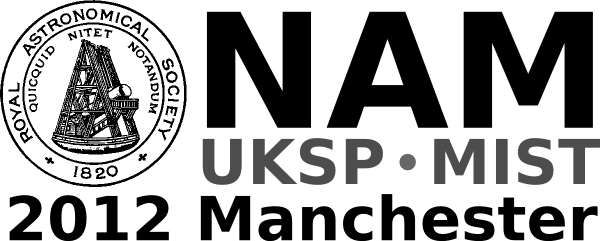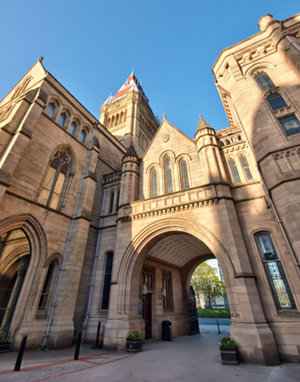UK-Germany National Astronomy Meeting NAM2012
Solar Eruptions Cause Sun Quakes
Royal Astronomical Society press release
RAS PR 12/25 (NAM 16)
Friday 30 March 2012
A study led by UCL’s Mullard Space Science Laboratory has shown for the first time that sunquakes can be produced during eruptions of magnetic field and charged particles, as the immense magnetic structure blasts off into the Solar System. The results will be presented by Dr Sergei Zharkov at the National Astronomy Meeting 2012 in Manchester on Friday 30th March 2012.
The first observation of a sunquake was reported by Kosovichev & Zharkova in the late 1990s. During the last decade it has become well established that explosions in the Sun’s atmosphere, known as solar flares, can create sunquakes through the impact of powerful beams of particles which travel into the Sun. This new study shows that eruptions of material known as coronal mass ejections are also able to produce sunquakes.
The authors studied an eruption that took place on 15 February 2011 and found that sunquakes 1000 times more powerful than the Great East Japan Earthquake, March 2011, were triggered at the two ends of the erupting rope of magnetic field. This indicates that the sudden expansion of the magnetic field that takes place as the eruption occurs is likely to play an important role in generating the quakes. The eruption raced through the Solar System with an average speed of 600 km/s and was Earth directed, driving a geomagnetic storm and a beautiful display of the aurora when it reached us.
“Sunquakes were first predicted in 1972 by Wolff and are seen at the Sun’s surface as circular ripples emanating outward, looking much like those produced as a stone is dropped into to a pond. However, they are actually caused by sudden a release of energy below the solar surface that produces sound waves which bend and travel up to the surface of the Sun, lifting it and producing the ripples,” said Zharkov.
These spectacular events are helping scientists understand how energy and momentum are transported from the Sun’s atmosphere down to the surface and into the interior. With solar activity currently increasing, and due to peak in 2013, more sunquakes will be observed helping unravel the mechanisms that cause them.
IMAGES AND ANIMATIONS
Images and animations can be found at: http://mssl.ucl.ac.uk/~sz2/pressrelease/
Credits: Courtesy of NASA/SDO and the AIA, EVE and HMI science teams / Zharkov/Green/MSSL/Parker. The SOHO/LASCO data used here are produced by a consortium of the Naval Research Laboratory (USA), Max-Planck-Institut fuer Aeronomie (Germany), Laboratoire d'Astronomie (France), and the University of Birmingham (UK). SOHO is a project of international cooperation between ESA and NASA.
MEDIA CONTACTS
NAM 2012 Press Office (0900 - 1730 BST, 27-29 March; 0900 - 1630 BST 30 March)
Room 3.214
University Place building
University of Manchester
Manchester
UK
Tel: +44 (0)161 306 7313
Dr Robert Massey
Royal Astronomical Society
Mob: +44 (0)794 124 8035
Email: rm@ras.org.uk
Anita Heward
Royal Astronomical Society
Mob: +44 (0)7756 034 243
Email: anitaheward@btinternet.com
Dr Klaus Jaeger
Pressereferent / Press Officer im Vorstand der Astronomischen Gesellschaft
Tel: +49 6221 528 379
Email: pressereferent@astronomische-gesellschaft.de
Dan Cochlin
Media Officer (Faculty of Engineering and Physical Sciences)
University of Manchester
Tel: +44 (0)161 275 8387
Email: daniel.cochlin@manchester.ac.uk
SCIENCE CONTACTS
Dr Sergei Zharkov
Mullard Space Science Laboratory
Tel: 0790 5784886
Email: sz2@mssl.ucl.ac.uk
Dr Sarah Matthew
Mullard Space Science Laboratory
Tel: +44 (0)1483 204208
Email: sam@mssl.ucl.ac.uk
NOTES FOR EDITORS
NAM 2012
Bringing together more than 900 astronomers and space scientists, the National Astronomy Meeting (NAM 2012) will take place from 27-30 March 2012 in the University Place conference centre at the University of Manchester in the UK. The conference is a joint meeting of the Royal Astronomical Society (RAS) and the German Astronomische Gesellschaft (AG) and is held in conjunction with the UK Solar Physics (UKSP: www.uksolphys.org) and Magnetosphere Ionosphere Solar Terrestrial (MIST: www.mist.ac.uk) meetings. NAM 2012 is principally sponsored by the RAS, AG, STFC and the University of Manchester.
The Royal Astronomical Society
The Royal Astronomical Society (RAS: www.ras.org.uk), founded in 1820, encourages and promotes the study of astronomy, solar-system science, geophysics and closely related branches of science. The RAS organises scientific meetings, publishes international research and review journals, recognizes outstanding achievements by the award of medals and prizes, maintains an extensive library, supports education through grants and outreach activities and represents UK astronomy nationally and internationally. Its more than 3500 members (Fellows), a third based overseas, include scientific researchers in universities, observatories and laboratories as well as historians of astronomy and others.
The Astronomische Gesellschaft (AG)
The Astronomische Gesellschaft (AG: www.astronomische-gesellschaft.de), founded in 1863, is a modern astronomical society with more than 800 members dedicated to the advancement of astronomy and astrophysics and the networking between astronomers. It represents German astronomers, organises scientific meetings, publishes journals, offers grants, recognises outstanding work through awards and places a high priority on the support of talented young scientists, public outreach and astronomy education in schools.
The Science and Technology Facilities Council
The Science and Technology Facilities Council (STFC: www.stfc.ac.uk) is keeping the UK at the forefront of international science and tackling some of the most significant challenges facing society such as meeting our future energy needs, monitoring and understanding climate change, and global security. The Council has a broad science portfolio and works with the academic and industrial communities to share its expertise in materials science, space and ground-based astronomy technologies, laser science, microelectronics, wafer scale manufacturing, particle and nuclear physics, alternative energy production, radio communications and radar. It enables UK researchers to access leading international science facilities for example in the area of astronomy, the European Southern Observatory.
Jodrell Bank Centre for Astrophysics
The Jodrell Bank Centre for Astrophysics (JBCA: www.jb.man.ac.uk) is part of the School of Physics & Astronomy at the University of Manchester. JBCA is split over two main sites: the Alan Turing Building in Manchester and the Jodrell Bank Observatory in Cheshire. At Jodrell Bank Observatory, the new Jodrell Bank Discovery Centre is a key focus for our work in public engagement and education. Jodrell Bank is a world leader in radio astronomy-related research and technology development with a research programme extending across much of modern astrophysics. The group operates the e-MERLIN national radio astronomy facility and the iconic Lovell Telescope, hosts the UK ALMA Regional Centre Node and is home to the international office of the SKA Organisation. Funded by the University, the Science & Technology Facilities Council and the European Commission, it is one of the UK's largest astrophysics research groups.





